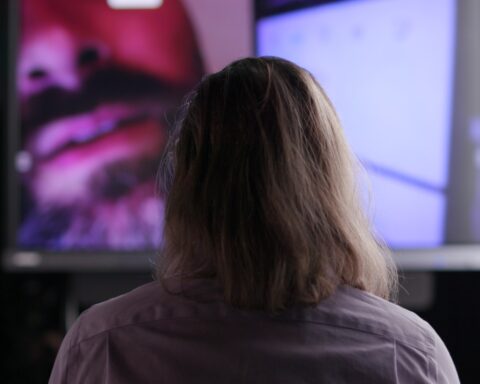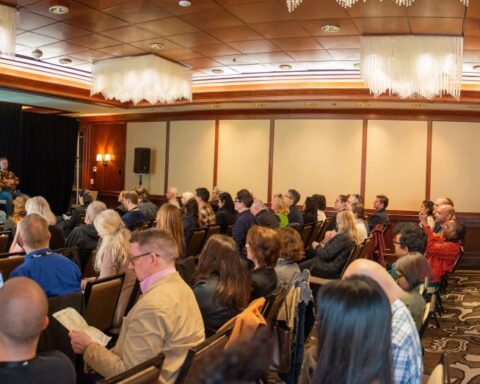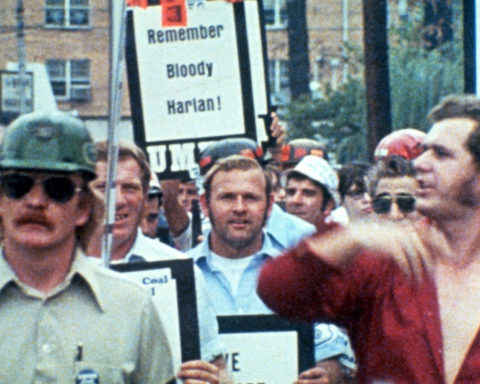“The world changes. Our stories live on.” That sounds nice, but resignation’s heavy breath fogs the surface triumphalism of this motto, currently touted by the NFB (National Film Board of Canada).
Questions about how to keep those stories in motion, and just whose sagas we’re talking about, remain unanswered by such an assertion, of course. The establishment of the NFB seven decades ago was intended to facilitate that storytelling, and certainly the company’s regional outposts were designed to address some of the who part. Over the years, they’ve managed to engage and support countless beginning filmmakers in small towns and urban centres—as well as inspiring the name of a leading Quebec electronic band.
There’s been considerable nail biting this decade, however, especially since Stephen Harper took over the reins up here just as Obamamania was simmering down south. The relentless pullback of federal funds, the demise of the Canadian Film and TV Fund, and increasing centralization in all governmental bodies—not unrelated things, to be sure—have led to more than the already high levels of anxiety in creative sectors.
Earlier this year, a campaign was launched by the Canadian Union of Public Employees (CUPE), aimed at cutting back the cutbacks. A series of CUPE ads featured top filmmakers pleading with Ottawa not to let the Board “waste away.” But not all the collateral damage has come from outside the Board’s head office in Montreal. A little less than two years ago, tectonic waves went through the West Coast filmmaking community when Rina Fraticelli, the well-liked head of the NFB’s Pacific and Yukon Centre was given the axe in a manner more common to corporate environments than in the generally collegial cultural sphere.
Although she started as a dedicated Easterner, Fraticelli’s late ’80s time with the female-centric Studio D (which didn’t survive budget-cutting in the next decade) helped kick-start the busy careers of Left Coasters like Janis Cole, Ann Marie Fleming, and Sook-Yin Lee. Her arrival was seen as a potential boost for local voices, but the push for slightly more autonomy in the region was apparently seen by Tom Perlmutter, a veteran docmaker who became director general of English programming in 2001, as antithetical to the way things were increasingly being run from back east.
The blow came in late 2007, although tension eased fairly quickly when it became clear that her successor would be filmmaker Tracey Friesen, already working as an editor and in-house NFB producer, most notably on Velcrow Ripper’s award-grabbing ScaredSacred, for a number of years before being asked to run things.
Last year, TV veteran Cindy Witten—who cut her exec-production teeth out west, working with Selwyn Jacobs on Linda Ohama’s Obachan’s Garden — moved into Perlmutter’s job back east as he ascended to the company’s top job as film commissioner. Personable indie dude Yves Ma was tapped to fill Friesen’s shoes as hands-on overseer, as she started spending more time with spreadsheets and conference calls.
The ascension of Friesen, wrapping up an MBA from Simon Fraser University just as she got the job, was reassuring to the small community of docmakers trying to eke what they laughably call a living from their documentary skills. And few, it turned out, were more pleased than the woman she replaced—after a period of adjustment, of course.
“Well, it was rather abrupt,” recalls Fraticelli, who stayed in Vancouver to pursue personal projects, as well as her work with the local office of Women In Film and Television. “I had been clashing with Tom for a couple of years, on philosophical grounds, so it wasn’t a complete shock. To be honest, I think Tracey is little more level-headed than I am,” she says with a laugh. “She’s a smart and savvy person who is tremendously committed to the community here, and she will do as well as anyone possibly can, under these circumstances, to champion the values of local artists.”
There are additional constraints in this highly centralized institution. Betsy Carson has more than two decades under her belt as one of B.C.’s top producers, raising funds and opportunities for doc directors like Nettie Wild, Mark Achbar, Cari Green, Gary Marcuse, and Harry Sutherland—all of whom have learned more, in an age of diminishing resources, than they ever wanted to know about the fine art of coproduction. “As long as I have worked with the NFB,” states Carson, “there have been cutbacks, cutbacks, cutbacks. Over the last 15 years, the first places to get cuts were always the regions. Under the Conservative government, things are getting chopped left, right, and centre, and the Film Board is one of those institutions that certain people complain about.”
Naturally, this knowledge doesn’t do much to ease the path of long-time freelancers attempting to sustain ongoing relationships with the Board. “The policies coming from head office make it increasingly difficult to do co-productions, but in that situation at least I still exert some control. These days, I can only recommend that beginning filmmakers let the Board have full control. I do understand that they are concerned with branding, and at this point they are struggling to keep their brand alive. We have to be careful how we frame our complaints, because at least it’s still there!”
Carson looks to the Board’s mentorship programs and growing emphasis on non-linear media as “cutting-edge” ways of engaging film neophytes. In RiP: A Remix Manifesto, B.C.’s innovative young Brett Gaylor sets out a model for the new doc. The zippy-looking film tackles issues of copyright and ground-up creativity in the post-analogue century, and it appears that these concerns will be increasingly those of a more digitally-minded NFB. But that feature was actually produced through the Quebec office.
The Western plant now has CBC-3’s Rob McLaughlin as its new-media guru— although that is simply because he lives there. McLaughlin, too, answers directly to Montreal. This comes at a time when the nature of film distribution and consumption has been changing in ways we still can’t fully comprehend. The urban videotheques (like the vast one here on Howe Street, near the Pacific Cinémathèque) and free public screenings dried up in the mid- ’90s, and on-line streaming (with 700 titles now available at nfb.ca) is now emerging as the way to go for continued access to the NFB’s library. That’s also how youngsters can stay aware of the Board’s long history as the repository of national talents and eccentricities.
The biggest change on the horizon for the Pacific office, however, is literally more concrete. This fall, it will move to bigger digs at what was, in another era, the Woodward’s building. The new site will be part of a development project intended to anchor a revival in one of Canada’s most depressed zones, the Downtown Eastside. This towering centre is the vision of architect Gregory Henriquez, who planned it as a way for government offices to share space with Simon Fraser University’s new School for the Contemporary Arts, plus numerous everyday amenities being assembled in order to help bring the area, and perhaps the organization we’re talking about, back to life.
Friesen says her new square footage will be slightly reduced from their multi-floor office on Hemlock Street (where, it must be said, it took several years for a street shingle to be hung). But there will still be three editing suites available to resource shy moviemakers. “Most importantly,” the new boss insists, “it will make us stand out in the community.”
The potential psychological impact should not be underestimated. The Film Board is clearly at a crossroads. With the recent retirement of Svend-Erik Eriksen, given his special attachment to funky animation, who can tell whether the current emphasis on computer-driven work will fill that void? Emily Carr University of Art + Design animation prof Martin Rose now works half-time at the Board, so the influx of fledgling talent should continue apace. It remains to be seen whether interfacing with academic sites and temporary developments, like the Cultural Olympiad (The Canada Code), will offer urbane renewal to the old girl.
“There are a lot of complementary skills here now,” Friesen explains, “which I think speaks to the future of the Board, with people able to cross over genres and institutions. We dabble in alternative drama while keeping up with the documentary community and getting more preoccupied with the digital sphere.” Of course, changes on that last front will likely lead to more homogenization of product, and the ephemeral nature of regional expression may be stretched even further.
Friesen thinks the strong commercial animation scene in Vancouver—there’s a lot of post-production and visual-effects work here, especially for Asian-made series and features—keeps unique talent primed for original work. “I don’t know that the Montreal animation community has that rootedness in day-to-day work. When people here are ready to push things a bit and want to spin off into edgier, more auteurish stuff, they can come to us for that.” In some cases, that means battle-scarred ’toonsters, like International Rocketship pilot Marv Newland, are still heading to the Board for small, experimental work. (That will make 40 years of NFB action for him.)
“We retain our commitment to emerging filmmakers,” Friesen insists. “I mean, we are kind of nothing here without beating the bushes to find out who is there with raw talent. In the current Film Board model, we can still surround these people with a ton of support. On the other hand, there is also a desire to work with seasoned directors, with good track records, who are not too set in their ways but have signature styles.”
The regional honcho figures things are scariest in conventional tube land, where much NFB product traditionally ended up in the past. “The independent community that is used to earning its living from producing a reasonable volume of TV-based documentaries. Those creators are the hardest hit, and we get lost there as well. Our first commitment is to projects that are truly different and interesting, and that’s where the resources have to go first.”
Winnipeg-bred Angela Heck, publicist for the Pacific office during much of this decade—now working the other side, as a producer—calls the NFB “the last of a dying breed in the world.” She’s referring to its international rep as a publicly funded body dedicated to digging up decidedly noncommercial prospects. “Whatever the current problems may be, they really are about nurturing new talent in far-flung places.”
Although the Board has never been mandated to gather specifically characteristic tales of each region, Friesen insists that patterns have emerged organically. Geography has something to do with that. But everyone POV contacted was able to point to the West’s intense engagement with addiction and disability issues as a leading indicator of Western proclivities, in this decade anyway. From the autobiographical works of Bonnie Sherr Klein to Wild’s Bevel Up and Murray Siple’s currently circulating Carts of Darkness, physically challenged and socially engaged filmmakers are rushing into the wide open spaces of British Columbia and the Yukon. A renewed emphasis on putting cameras in the hands of First Nations storytellers, especially young ones, bodes well for regional representation.
“Success really does come from the margins,” is the way Fraticelli puts it. “In Vancouver, we are literally on the edge, and the edge is where you find people with individual vision—artists who are generally five or six years ahead of the awards and other kinds of recognition. There’s always a danger in thinking too much in the short term.” But if the Board was to be shuttered, in the cause of progressive conservatism or whatever they are calling nearsighted greed these days, would the feisty nature of the region—with publicly funded outfits like Cineworks and the Cinémathèque, and already struggling indie houses kicking in—be able to provide a saving alternative? Would our stories, especially the new ones, really live on?
“The short answer,” Fraticelli concludes, “is no.”
The longer answer is definitely more complicated.
“My own view is that media artists will continue to swim against the tide of homogenization and market-driven directives to tell our awkward, difficult, beautiful, undigested original stories. And, against all odds, they’ll find ways to share them with the rest of us.”











